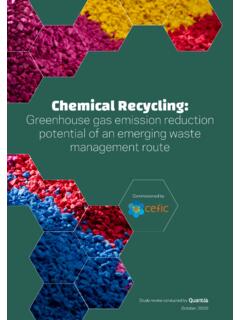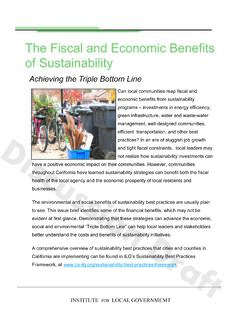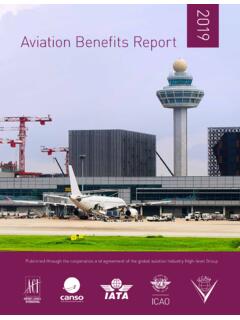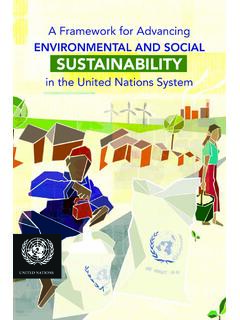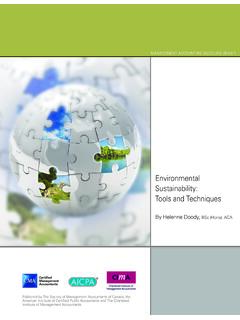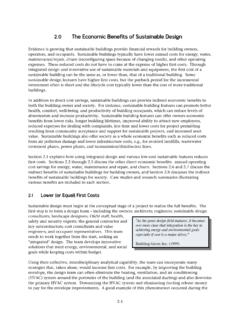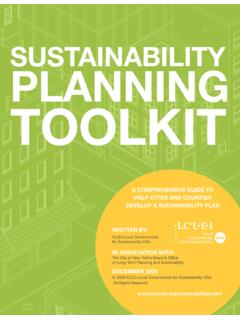Transcription of Economic Analysis of the Impacts of the Chemicals Strategy ...
1 Economic Analysis of the Impacts of the Chemicals Strategy for sustainability Phase 1 Report Report for the European Chemicals Industry Council (Cefic) Final Report for European Chemicals Industry Council (Cefic) ED 14790 | Issue number 1 | Date 18/11/2021 Economic Analysis of the Impacts of the Chemicals Strategy for sustainability Phase 1 Report Ref: ED 14790 | Final Report | Issue number 1 | 18/11/2021 ii Customer: [European Chemicals Industry Council (Cefic aisbl)] EU Transparency Register n 64879142323-90 Contact: Becca Johansen, 21 Prince Street, 1st Floor North, Bristol, BS1 4PH, UK T: +44 (0) 1235 753 104 E: Customer reference: [ED14790] Confidentiality, copyright and reproduction: This report is the Copyright of the European Chemicals Industry Council (Cefic) and has been prepared by Ricardo Energy & Environment, a trading name of Ricardo-AEA Ltd under contract ED14790 dated 2nd February 2021. Views expressed in this report are not the official opinion or position of Cefic.
2 The report is the outcome of Ricardo s assessment of the overall impact of the EU Commission s Chemicals Strategy for sustainability (CSS) on the European chemical industry at EU27 level, based on public literature and data collected from companies producing or using chemical substances, in compliance with competition law. It is not a forecasting exercise, but an estimation of potential future Impacts based on available data, a series of assumptions and uncertainties. It is aimed to inform the policy debate on the CSS. While the report has been designed using the best knowledge currently available, it is to be relied upon at the user s own risk. No representations or warranties are made with regards to its accuracy or completeness, and no liability will be accepted by Ricardo nor Cefic for damages of any nature whatsoever resulting from the use or reliance on its contents. The contents of this report may not be reproduced, in whole or in part, without the specific prior written permission of the European Chemicals Industry Council (Cefic).
3 Author: Becca Johansen, Brais Louro, Inge Kukla, Graham Pattle, Jodie Denmark, Chris Hughes (Ricardo) Daniela Jeronimo Roque (Toxminds BvBA) Approved by: Tim Scarbrough Signed Date: 18/11/2021 Ref: ED [14790] Ricardo is certified to ISO9001, ISO14001, ISO27001 and ISO45001 Economic Analysis of the Impacts of the Chemicals Strategy for sustainability Phase 1 Report Ref: ED 14790 | Final Report | Issue number 1 | 18/11/2021 iii Executive summary Introduction This study has been commissioned by the European Chemicals Industry Council (Cefic) to assess the business Impacts to the European (EU) Chemicals industry of selected actions from the EU Commission s (EC) Chemicals Strategy for sustainability (CSS): Towards a Toxic-Free Environment1. This study shall feed into the Cefic response to the EU Commission s CSS Impact Assessments. The European Union has one of the most comprehensive chemical regulatory frameworks in the world. This knowledge base helps to inform regulatory actions in other regions and has become a model for the safe use of chemicals2.
4 The EU has been successful in maintaining the functioning of the single market, whilst reducing the risks to human health and the environment. This being said, studies3,4,5 have noted the need to continue to improve current practices to ensure a higher level of protection. The European Green Deal6 was launched in December 2019 and sets out the European Commission s commitment to tackling environmental challenges such as atmospheric warming, climate change, environmental pollution and degradation. It is an integral part of the Commission s actions to implement the United Nation s 2030 Agenda and the sustainable development goals. To ensure the toxic-free environment ambition is met, the EU Green Deal stated that the Commission will present a Chemicals Strategy for sustainability (..) to protect citizens and the environment better against hazardous Chemicals and encourage innovation for the development of safe and sustainable alternatives 7. The CSS was launched in October 2020, to provide a new long-term Strategy for Chemicals policy, in line with the aims of the EU Green Deal.
5 The CSS strives for a toxic-free environment, where Chemicals are manufactured and used in a way that maximises their societal contribution but avoids causing harm to the environment or the population, now and in the future. The Strategy contains around 80 action points which seek to simplify and strengthen the Chemicals legislative framework to build a comprehensive knowledge base that can support evidence-based policy making in order to facilitate innovation of safe and sustainable Chemicals , and the protection of human health and the environment. Study Aims and Scope This study seeks to assess the business Impacts to the EU Chemicals industry as a result of selected actions from the CSS. The study is composed of two phases: Phase 1: Addition of hazards to the CLP Regulation (EC) No. 1272/20098; The extension of the Generic Risk Approach (GRA); The introduction of a Mixture Assessment Factor (MAF). Phase 2: Requirements for Polymer Registration; 1 European Commission (2020) Communication from the Commission to the European Parliament, the Council, the European Economic and Social Committee and the Committee of the Regions, Chemicals Strategy for sustainability Towards a Toxic-Free Environment, COM(2020) 667 Final.
6 Available from: 2 A. Bradford (2020) The Brussels Effect: How the European Union Rules the World. New York: Oxford University Press 3 RPA et al (2017) Study on the regulatory fitness of the legislative framework governing the risk management of Chemicals (excluding REACH), in particular the CLP Regulation and related legislation. Available from: ( ) 4 Amec Foster Wheeler et al , 2017. Study supporting the Fitness Check on the most relevant Chemicals legislation ( Fitness Check + ) 5 European Commission. (2020). Commission Staff Working Document Fitness Check on endocrine disruptors. SWD(2020) 251 final. Available from: 6 European Commission (2019) Communication from the Commission to the European Parliament, the European Council, The Council, The European Economic and Social Committee and the Committee of the Regions: The European Green Deal. COM(2019) 640 Final. Available from: 7 Ibid footnote 6 8 Regulation (EC) No. 1272/2008 of the European Parliament and of the Council of 16 December 2008 on classification, labelling and packaging of substances and mixtures, amending and repealing Directives 67/548/EEC and 1999/45/EC, and amending Regulation (EC) No 1907/2006.
7 The Official Journal of the European Union. Available from: Economic Analysis of the Impacts of the Chemicals Strategy for sustainability Phase 1 Report Ref: ED 14790 | Final Report | Issue number 1 | 18/11/2021 iv The implementation of the PFAS ban; The application of an export ban; and Extending REACH Registration requirements to Chemicals produced in low tonnage bands. The work has followed the EU Commission s Better Regulation Guidelines9 where possible, although as this is an Analysis of business Impacts only, costs and benefits to human health and the environment have not been considered. It is expected that the Impacts to human health and the environment will be considered in the European Commission s Impact Assessments related to the CSS. This report presents the findings of an Analysis of the business Impacts of: The addition of hazards to the CLP Regulation The extension of the Generic Risk Approach (GRA). This study ran from February to October 2021.
8 The scope of this study is related to business Impacts such as compliance and operating costs, as well as manufacturing and use restrictions, incurred by Chemicals companies which place chemical products on the market (manufacture, import, formulation and sale) in the EU-27 and their responses to the regulatory changes (removal from the market, substitution, reformulation). Policy Context Chemicals play a fundamental role in the functioning of our daily lives. They are the building blocks of the products we rely on every day, they contribute to food security, and in some cases even help protect our health. But they can have negative effects. As Chemicals have wide dispersive uses and play such a key role in our daily lives there is a need to reduce harmful exposures, whilst also maintaining sustainable use. This is particularly true of Chemicals which demonstrate hazardous properties such as those which cause cancer or gene mutation, affect the reproductive, endocrine or immune systems, are persistent, bioaccumulative, mobile or toxic to the environment.
9 Exposure to these Chemicals is a threat to human health and the planet as a whole, potentially contributing to global crises such as climate change, biodiversity loss and environmental The EU has regulated the exposure of humans and the environment to hazardous substances for over 50 years, with the original Community legislation relating to classification of substances being adopted in 1967 (the Dangerous Substances Directive - 67/548/EEC) and extended to preparations (now termed mixtures) in 1988 (88/379/EEC). Chemicals policy has changed over the last half century from being reactive to evidenced risks to proactively identifying hazards and potential risk, and mitigating this. The EU Chemicals acquis has evolved, with many pieces of legislation being developed in parallel to those outlined above. The comprehensive EU Chemicals legislative framework now comprises around 40 pieces of legislation, including but not limited to: Regulation (EU) No.
10 1907/2006 on the Registration, Evaluation, Authorisation and Restriction of Chemicals (REACH)11; and Regulation (EC) No. 1272/2009 on the Classification, Labelling and Packaging of hazardous substances (CLP)12. As the overarching pieces of Chemicals legislation, the REACH Regulation and CLP Regulation introduced different regulatory management measures for substances, mixtures and, in the case of REACH, articles, which display a range of hazardous properties, with more restrictive risk management for those which are deemed to be of highest concern. Despite the increased regulatory 9 European Commission (2017) Better regulation: guidelines and toolbox. Available from: Better regulation: guidelines and toolbox | European Commission ( ) 10 Ibid footnote 1 11 Regulation (EC) No 1907/2006 of the European Parliament and of the Council on the Registration, Evaluation, Authorisation and Restriction of Chemicals (REACH). The Official Journal of the European Union.
